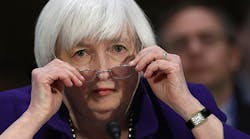In just a week, markets went from doubting a March rate increase to viewing one as a sure bet. The central bank’s top brass engineered the change by speaking in favor of a hike, culminating in Fed Chair Janet Yellen’s endorsement on Friday.
What changed to push central bank policy makers from the neutral stance that Fed watchers saw in their January meeting minutes to the brink of a rate increase? Not much, if you’re looking at U.S. data. The fact that nothing deteriorated was enough to clear the hurdle for a March rate move, especially because steady domestic data have come alongside a slowly-improving international outlook — a major shift from the situation at this time last year, when global risks helped to stay the Fed’s hand.
“There is almost no economic indicator that has come in badly in the last three months,” Fed Vice Chairman Stanley Fischer said Friday at a forum hosted by the University of Chicago’s Booth School of Business. Likewise, Yellen said employment and inflation are evolving in line with the Federal Open Market Committee’s expectations. While prices haven’t broken out dramatically to the upside, they’re still moving toward the Fed’s goals.
Unemployment has “essentially met” what officials see as full employment, Yellen said Friday. Low joblessness isn’t a major change from last year, though wages are very slowly crawling higher, suggesting that the labor market is getting tighter.
And the outlook for output growth hasn’t changed much. New York Fed President William Dudley said the economy is still on about a 2% growth track, speaking in a CNN interview on Feb. 28. He then signaled a willingness to raise rates soon.
In short, the U.S. economy isn’t experiencing a breakout moment, but it’s holding up. Evidently, that’s all the Fed needed to see.
The global outlook, though, has shifted, if you listen to Yellen and Governor Lael Brainard. In 2016, the Fed entered the year looking to raise rates, but tumult in Chinese markets and Britain’s vote to exit the European Union helped to keep them on hold until December. This year, “the prospects for further moderate economic growth look encouraging, particularly as risks emanating from abroad appear to have receded somewhat,” Yellen said Friday.
“Foreign growth is on more solid footing and risks to the outlook are as close to balanced as they have been in some time,” Brainard said March 1.
Yellen said China “has continued to grow and its management of its currency has been better understood and led to less volatility,” while Brainard said government officials there had “stabilized growth and calmed fears of financial instability.” As the economic environment stabilizes, China’s manufacturing sector is posting gradually better results.
Yellen noted that Brexit negotiations and concerns about European integration could continue to pose a risk, but Brainard said Europe’s “recovery has proven to be increasingly resilient.” Euro area headline inflation has been climbing, providing fresh arguments to those calling for an exit from the European Central Bank’s monetary stimulus program, though core inflation remains below 1%. Euro-area unemployment was unchanged at 9.6% in January, the lowest since May 2009.
At the end of the day, it wasn’t an outsize improvement in data at home that dealt the Fed a winning hand in early 2017: growth remains in a holding pattern, progress in headline inflation is energy-tied, and the job market is growing at a similar clip to last year. And while domestic fiscal policy seems increasingly likely to turn stimulative as President Donald Trump promises tax cuts and infrastructure spending, Yellen and her colleagues say it’s too early to take that into account when setting policy.
What has changed significantly is that threats from abroad are looking less scary. As long as that remains the case and U.S. data remain steady between now and March 15, the Fed appears poised for its first non-December rate increase since June 2006.
By Jeanna Smialek



